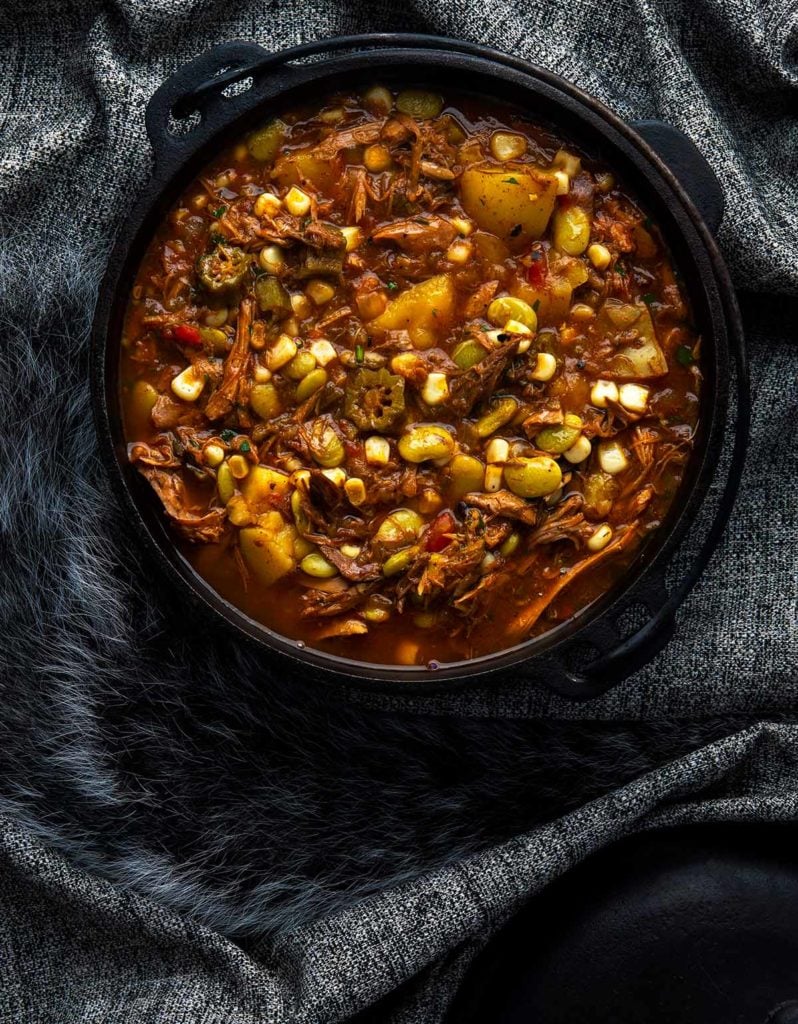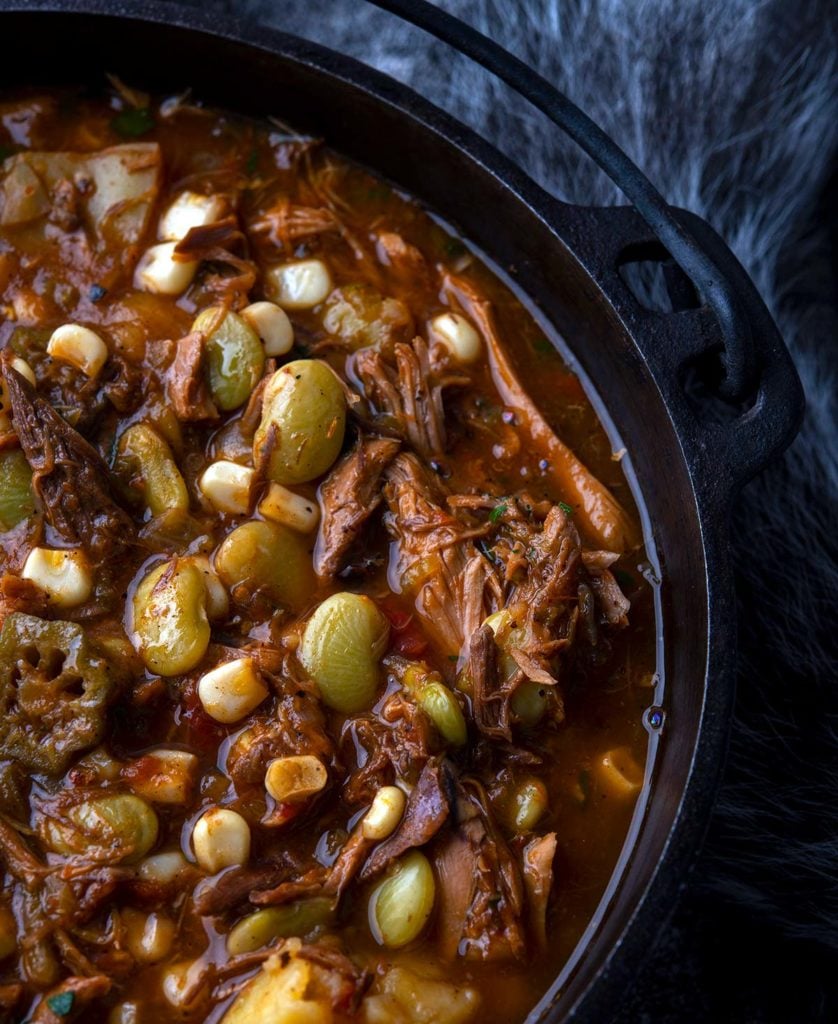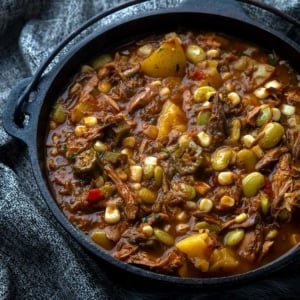As an Amazon Associate I earn from qualifying purchases.
Brunswick stew is an iconic Southern dish, stuffed with controversy as well as pretty much everything else in your garden. After researching dozens of recipes dating back to 1855, I’ve come up with a Brunswick stew recipe I think represents the tradition well, and is as easy or as hard as you want to make it.
And while yes, squirrel is the traditional meat in this stew, even many 19th Century recipes use easier-to-find meats. More on that in a bit.

I might as well start by busting the myth that Brunswick stew comes from Georgia. There is no evidence of this stew being made in Georgia earlier than the 1890s, while there are lots of references predating that coming from Virginia, and in fact the first reference to Brunswick stew in Georgia refers to it as “an old Virginia stew.”
History of Brunswick Stew
The absolute first reference to Brunswick stew I could find is in a novel called The Hidden Path, written in 1855: “There are nothing but little nubbins with not more than a dozen grains to the ear, heaving a sigh at the consequent delay of the Brunswick stew she had hoped to have smoking upon her board that day.”
As you can see, no details, just that it’s a thing. The author assumed people knew what Brunswick stew was.
Officially, Brunswick stew was first made by Jimmy Matthews, the camp cook for a party of rich Virginians, in 1828. There’s a plaque in Brunswick County, Virginia, to this effect. While the rich people were off hunting something grander, so the story goes, Jimmy went out squirrel hunting for the camp, got a few, then made this stew.
Exactly who Jimmy Matthews was is a mystery. Some sources say he was a slave, others a poor white man who was employed by Creed Haskins, one of the hunters.
This prototype of Brunswick stew hinged on squirrels, stale bread, onions and butter. Sounds like a typical hunt camp throw-together even now. Only later did the stew become a repository for an entire garden.
While this is the written history of Brunswick stew, you can see clearly its the native origins — corn, beans, tomatoes, potatoes, game meats, all thrown in a pot with no initial browning. It’s very close to the idea of a traditional native Three Sisters stew.
One interesting note is that in its early versions, Brunswick stew appears to be a little spicy. See this description from the Southern Literary Messenger in 1863:
There was no other dish but the Brunswick stew and that was enough, for it contained all the meats and juices of the forest and garden magnificently conglomerated and sublimed by the potent essence of fiery Cayenne pod upon pod lavishly thrown in a dish capacious as the Mediterranean held it and it lowered aloft like Vesuvius smoking gloriously.
Southern Literary Messenger, 1863
Brunswick stew continues to evolve throughout the 1800s and early 1900s, and it’s that second period where Georgia-style Brunswick stew comes into play: It’s main difference is that it includes either leftover pulled pork barbecue, or fresh barbecue, and often some of the sauce.
Mine does neither, as this is a Virginia Brunswick stew.

Elements of Brunswick Stew
With very few exceptions, all recipes for Brunswick stew include the following:
- Meat of some sort, usually but not always lighter meats
- Lima or butter beans, fresh, frozen or dried
- Tomatoes, often both pureed and diced
- Corn, either sweet or field corn, almost always fresh or thawed
- Lots of butter mixed in at the end of cooking
Optional but common additions include:
- Potatoes, usually but not always peeled
- Salt pork, bacon or ham
- Onion, occasionally sautéed but usually not
- Okra and cayenne pepper
- Worcestershire sauce
- Fresh parsley as a garnish
I’ve seen 19th Century recipes with sweet potato and carrots, too, but those are rare.
As I mentioned above, squirrel is the soul of a Brunswick stew recipe, but even in the 1800s, many recipes left it out in favor of chicken, pork or rabbit. A few recipes use beef shank.
Mrs. Elliot’s Housewife, written in 1879, calls for chicken or squirrels, but says duck or turkey are fine. Use legs if you’re going that route.
My Brunswick Stew Recipe
This is similar to, but not exactly the same as, my Brunswick stew recipe in my book Pheasant, Quail, Cottontail. That one’s great, but this recipe hews closer to the way all those 19th Century recipes did it.
Unlike a lot of modern stews, this one starts with water and/or broth, and the meats. No browning, not initial sautéing. None of the 19th Century recipes does the initial sear, and browning of meats and onions is really a French technique we Americans picked up in the late 1800s.
You add your meat, ideally squirrels and whatever else you want, simmer this gently, then add other ingredients as they ought to be. What that means is that a Brunswick stew starts as broth and meat, and only once you can strip the meat from the bone do other ingredients arrive at the party.
(Here’s how to cut up a squirrel for cooking.)
The meat, indeed the whole stew, is meant to be kinda hammered, as in cooked a long, long time — very much like Brunswick stew’s cousin, Kentucky burgoo.
This is an excellent candidate for a slow cooker because there is no browning step. Just put everything in if you want, and let it roll all day until you’re ready to eat.
A few things should go in at the end, though. Definitely the butter, and you’ll want to tinker with the flavors with Worcestershire and or Tabasco sauce, salt and black pepper.
Preserving the Stew
Once made, Brunswick stew freezes very well and you can pressure can it, too. You’ll want to follow your pressure canner’s instructions, but in general it will be 75 minutes at 10 psi (if you live from sea level up to 1000 ft in altitude).
It will keep a week or so in the fridge.
Brunswick Stew
Ingredients
- 3 pounds squirrel meat, cut into serving pieces (see below for options)
- 1 large onion, chopped
- 2 quarts chicken broth
- 1 28- ounce can of crushed tomatoes
- Salt
- 2 cups diced tomato (optional)
- 1 pound potatoes, cut into chunks
- 1 pound frozen baby lima beans (or fresh)
- 1 pound corn kernels, fresh or frozen
- ½ pound okra, sliced (optional)
- 1/3 cup minced fresh parsley
- 1/4 cup butter
- ¼ cup Worcestershire sauce, or to taste
- Tabasco or other hot sauce, to taste
- Black pepper to taste
Instructions
- Pour the broth along with another quart of water into a large, lidded pot such as a Dutch oven. Bring this to a boil, and add the onion and salt to taste. Add the squirrel or other meat and skim any foam that forms. Simmer gently until the meat is falling off the bone, anywhere from 1 to 3 hours.
- Fish out all the meats and remove the meat from the bones; this makes the stew a lot easier to eat. Discard the bones.
- Add all the tomatoes and the potatoes and simmer 30 minutes.
- Add the beans, corn and okra and simmer another 30 minutes.
- Stir in the remaining ingredients until well combined. Tinker with seasonings and serve. Cornbread is a nice accompaniment.
Notes
Keys to Success
- Obviously most people won’t have access to squirrel. Use chicken or rabbit instead. Other options are leftover pork barbecue, country ribs, pork shoulder or a beef or venison shank. Duck or goose legs or turkey legs are other good choices.
- Feel free to play with your own version of the stew, using the guidelines in the article above.
- I personally like this stew a little spicy, so I add either cayenne powder or fresh hot chiles to the mix. There is historical precedent for this, if it makes you feel better.
- When in doubt, cook it longer. Brunswick stew should be thick.
Nutrition
Nutrition information is automatically calculated, so should only be used as an approximation.






Originally in the early colonies it was known as rabbitt stew. Old oral traditions of old ethnic Br’er Rabbit stories fed the food naming customs. Thus the stew was named Br’er Goo, or as it has been known for at least a hundred years or more in western KY as Burgoo. Many early settlers to that area of KY were southeast VA transplants, many from Brunswick County. You begin to see the parallels? In KY, bbq for a century or more has been the base for Burgo with vegetables thrown into a large pot mostly as leftovers. The unique resulting flavors result from hickory smoked pork and mutton. If you want an an authetic brunswick stew recipe, connect with the old folks of western KY. My family had one too, I am originally from there.
Another home run from Hank. Used wild boar front shoulders. Smoked until almost shreddable. Then into pot with broth to finish it off! My OH My! Perfect for cold raining day here in the Lowcountry! Going to be really cold tomorrow and I bet this stew will be even better then.
I acquired an old cookbook from my grandmother, a reprint of Marion Cabell Tyree’s Housekeeping in Old Virginia originally written in 1879, which has four versions of Brunswick Stew. All are very similar apart from a couple of different ingredients.
One uses beef shank, one uses red pepper, and three of them use squirrels or chicken, but all start with putting meat in water and not browning first as noted above. I’m making this version tomorrow for some guests I’m having over as I have a surplus of squirrels to use…can’t wait!!
Great food history. Perfect timing as deer season is winding down and the squirrels had a great year in Central Maryland. We had the best acorn year in a long time.
That Southern Literary Messenger quote really fires the imagination; thanks Hank!
Love this stew!!! Great with deer neck!
Going to add sweet potatoes this round
I saw this today and it brought back childhood memories of eating Brunswick Stew at Colonial Williamsburg. I still remember it was my first time seeing okra! And as my parent were the kind of people who didn’t believe in wasting food, you ate everything, including the okra which I love to this day. So I decided I had to try to make this and honestly I don’t know why I’ve never made Brunswick Stew. I have fresh home canned tomatoes, fresh frozen corn and fresh lima beans! I stared out my window watching the many fat squirrels enjoy the birdseed, and I wondered….. but alas I caved and headed to the store for stew beef. I know it calls for lighter meats but the beef was lovely. Sadly no okra- fresh or frozen which is maybe better as it always seems to turn slimy on me. I just enjoyed an amazing bowl along with homemade sourdough bread. I used cooked frozen bacon I keep on hand and chopped that up instead of fresh bacon or ham. It still gave a lovely flavor. This was a great way to enjoy all of the corn and lima beans I put up. A person can really only eat so much succotash. I followed the instructions very closely but basically halved the recipe. It is wonderful and I always love reading the history of your recipes. Someday I am going to try to to make the sauce from immature black walnuts that is like Worchestshire sauce. I will definitely make this again!!
I recently moved to the NC/VA line around the Martinsville/ Danville area about a year ago from my home of 62 years in the SC foothills, and was amazed at how “makin’ a stew” was so prolific in this area…Churches, Fire Departments, Civic Groups and even Neighborhoods all revel in Cooking a large cauldron of 75-100 quarts of stew over a usual 2 day labor of love…everyone involved in the cooking along with usually their family and friends eat first on the day the stew is ready, then all partake of parting it out and selling it by the quart until it is gone, which usually is not very long-(the word is usually out days before!) Then the proceeds go to paying for the stew and the leftover funds go to a local charity, Firehouse, etc.
Coming from SC I was always privy to a good Brunswick Stew but it is rarely prepared in the quantity that these good folks here do it in, and I for one am thankful for this tradition and look forward to many more…this is a tradition that needs to be spread far and wide and passed along to promote friendship and fellowship wherever it is enjoyed…something that this Country is losing at an alarming rate I fear to say….so…Go ahead—“Y’all Cook a Stew won’t Ye!”
Ah, I was a transplant from Pennsylvania to your neck of the woods when I discovered Brunswick stew- by buying quarts locally. I’ve since moved from the NC/VA border to central VA but love this stew and am cooking this amazing dish on this cold day- using chicken. I love Mr. Shaw’s recipes. I was moved by your post- it is my hope that simple things like this can continue bringing folks together no matter our differences.
Hank,
This is spot on. I make about thousand quarts a year. I use two different recipes, Depending on who I’m cooking for.
I’m a big fan of adding sweet potatoes. Gives a great flavor as they melt away.
If the stew gets a little to hot to the taste, adding honey brings it back around.
Thanks again Hank